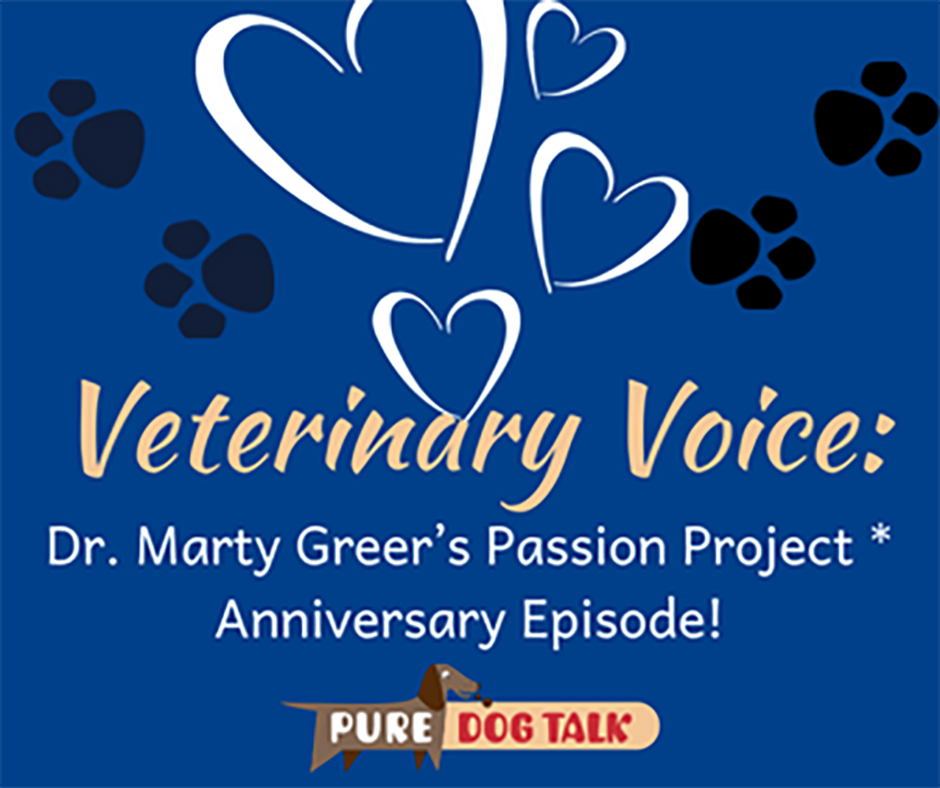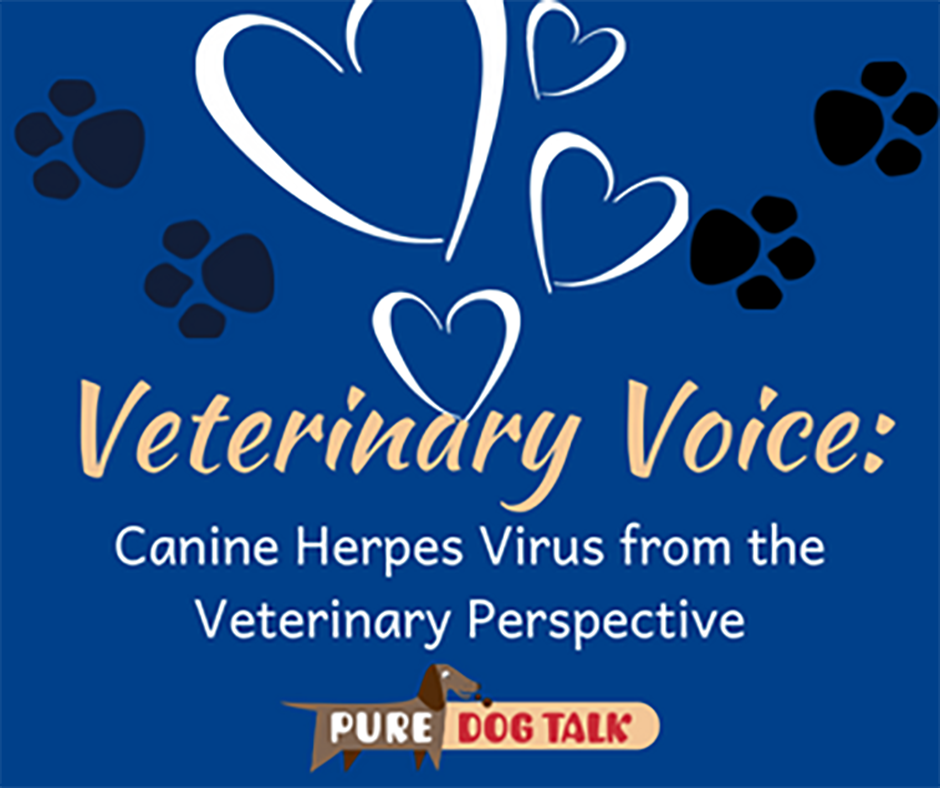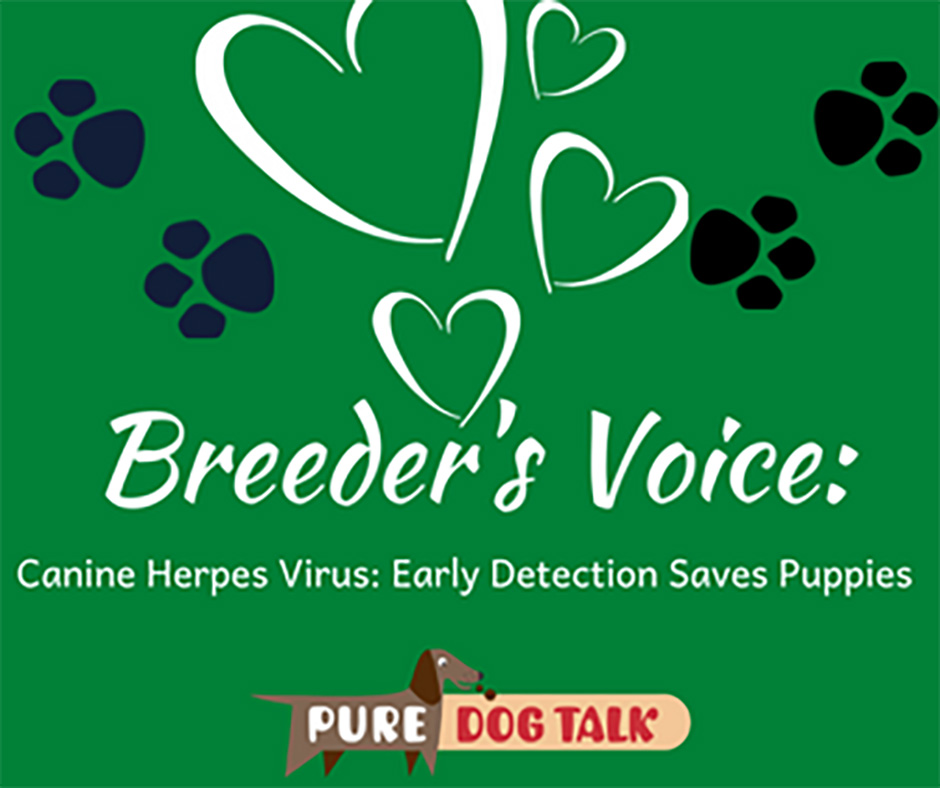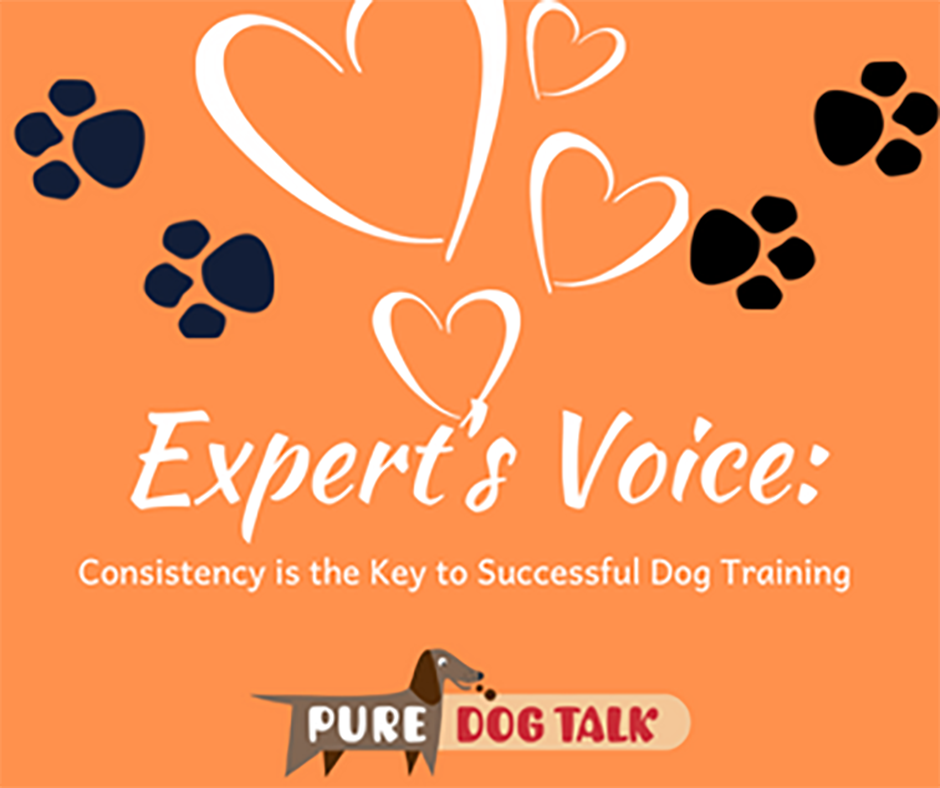555 – Dr. Gayle Watkins LIVE: Socializing Puppies Properly
Dr. Gayle Watkins LIVE: Socializing Puppies Properly
Four-time AKC Breeder of the Year in four different sports, Dr. Gayle Watkins, founder of Avidog, speaks about how we create working and competition dogs through proper socializing.
Watkins observes that socialization is building social relationships with humans and dogs. And the current method of socialization causes more harm than good. Puppy development should be manners, mental resilience, civility and trust, she posits.
“The vast majority of people think socialization ends at 16 weeks, the sensitive period. Those first four months so important to puppies. But most dogs need socialization or “development work” through 15 months,” Watkins said.
Another misconception Watkins notes is that 8 to 10 weeks is a fear *imprint* period, not a time in which dogs are necessarily more fearful.
“They’re not more afraid at that age,” Watkins said. “They’re going through continual progression towards fear that starts at 5 weeks. It’s what a canine is. They are fearful creatures. This is inherent in this species, so fear is inherent in dogs.”
“If you go online and you Google socialization and puppies, you’ll get a million hits, over a million hits, and you will get checklist after, checklist after checklist. This is not a checklist. We’re talking about teaching skills. What is stability? It’s the appropriateness of the dog’s response to stress.
“I also want to build resilience. Putting them under stress very, very early. So that they can be resilient. Resilience is the ability to bounce back from stress and frustration. If you think about it, we can’t make every puppy bombproof. More than anything else. It is built through inoculation to stress. When we are aiming for stability, we want to introduce stress to teach them the right behaviors. Here we must introduce stress to teach them to be resilient.”
Watkins’ insights on raising sensible, calm competition ready dogs is invaluable. Listen HERE to one of her first conversations on Pure Dog Talk, on bomb proofing your puppies.
556 – Building Trust with Your Puppy During Socialization
Building Trust with Your Puppy During Socialization
Dr. Gayle Watkins is back with part two of her presentation on proper socialization steps for raising competitive dogs.
Watkins emphasizes the need for the owner and puppy to build trust during early socialization. This means being a “control freak” about safe-guarding your puppy’s interactions with people, places and other pets.
“We are responsible for creating trust,” Watkins said. “We do it by being trustworthy and reliable. We are often not trustworthy with our dogs. Teach your puppy they can rely on you.
“Civility is the appropriateness of behavior around people and dogs,” Watkins added. “It is keeping your mouth shut, not biting anyone, not climbing on anyone. Not assaulting other dog or people as you are meeting. Civility is not the same as friendly. It does not require physical interaction. More important to teach our dogs indirect interaction, when they see a person or dog and do not interact.”
Getting puppies “out” to see urban centers, hear different noises and so forth does not also necessarily mean *meeting* other people and pets right away, Watkins noted. She also advocates for supervised puppy classes long before training classes begin.
Puppies handle stress best if we give them cues they can fall back on, Watkins said. If a situation is causing stress for the puppy, have them offer a sit and watch behavior, for example. She adds that forcing a puppy in to a situation that is clearly uncomfortable or scary for them can cause you to break the trust you are hoping to build with the puppy.
Watkins also discusses acquired fear or aggression in dogs that can actually be passed on in the whelping box – epigenetics is the name of this phenomena. Her emphasis on raising stable and trusting dogs springs from studies that indicate 80 percent of aggression is genetically based.
The bottom line, Watkins said, is that raising confident, stable puppies takes time, effort and commitment.
554 – Dr. Marty Greer’s Passion Project & Anniversary Episode
Dr. Marty Greer’s Passion Project & Anniversary Episode
Dr. Marty Greer, DVM and host Laura Reeves celebrate their fifth anniversary of sharing important veterinary topics on Pure Dog Talk.
Greer’s passion project is Breast Cancer Awareness in dogs.
“People sometimes forget that dogs get breast cancer too,” Greer said. “It’s not an uncommon kind of cancer to find in dogs, unfortunately. It is definitely linked to spaying at an older age. But, in spite of that, there are still some significant benefits in waiting to spay. So that’s a whole ‘nother topic.
“But essentially we see it in middle age to older, normally female dogs that were left intact after the age of two. So, anybody that’s breeding their dog is typically not going to spay before two because of health clearances, because she needs to mature before you breed her. So this means that almost every dog in a breeding program is gonna fall into a possibility of breast cancer. Mammary tumors, same thing, different term, all the same stuff.
“And I think it’s really important that people know that there isn’t a good treatment other than surgery. So early detection and surgery is going to be almost the only thing that we can offer.
“So, really, early detection, finding a nodule, taking it off when it’s small and then being very attentive for additional ones to develop is very important.
“Dogs have five sets of memory glands. The littlest ones are at the front between the front legs, and then they go down a nice string all the way down, usually in a fairly straight line. Every now and then they’ll be an extra nipple or something else thrown in, and that’s OK. It’s just a normal variation.
“But what you want to do is go along that chain that goes down, so feel from one nipple to the next and in between the nipples and just gently manipulate the skin so that you can see if you find anything that seems abnormal. A breast cancer nodule will feel firm, like a pea or a little cluster of peas. They’ll be firm. They won’t be those soft kind of masses. They won’t be on the belly button. They’ll typically be off to the side. The most common place to find a tumor, and the most serious tumors, are in the glands closest to the back legs.
“I strongly encourage people not to spend the money on a fine needle aspirate. A lot of veterinarians want to stick a needle in it and aspirate it, and because most mammary tumors are mixed of different cell types, that is not going to be an accurate assessment of what you have.”
Listen to the full episode here and then flash back to the first episode, introducing Dr. Greer.
553 — In Their Honor We Must Continue Their Paths
“In Their Honor We Must Continue Their Paths”
Tomorrow is All Saints’ day… It’s also Dia De Los Muertos … So I believe it is fitting to hold up our friends and loved ones today on All Hallows Eve….. Our tribe has lost legends, and legends in the making, just in the last few weeks, never mind during the course of the last couple years.
The days are shorter, colder and grayer today. The mottled leaves are falling. The dry grass is wilting. The winds of change heralding the season have arrived to scurry and swirl the fallen leaves in our path. The fog is settling in, the sun tilting on its axis. It feels as if the world is dying around us as the fall equinox wanes and the winter solstice creeps ever closer. When we lose friends and family this time of year, the anguish seems to seep deeper into our bones than at any other time.
Nonetheless, within our dog community, we are all, at the core, performers. The show must go on. No matter how devastated. How shattered. How destroyed our souls. So, we push through and push away and push down the heartache and angst and horror and sadness. Even as we collapse, crushed, with a dog on our chests to get through the night.
“Thinking of you and all the amazing people brought into your life through the dogs. Does not make their passing any less sad, but oh how it has enriched your life.”
This small note brought me such comfort. And I wanted to share this bright spot with all of you who are hurting right now. Our lives are all immeasurably enriched by our community of fellow dog lovers. Whether you started yesterday or have spent 50 years in this sport, the camaraderie and shared love of dogs is literally a lifeline for many.
The litany of those gone in the last few years is nearly unbearable. Respected judges. Gifted breeders. Talented handlers. Beloved family. Bastions of passion and commitment to purebred dogs who are so nearly irreplaceable.
Joe Gregory
Barbara Alderman
Pat Laurans
Pat Hastings
Linda Souza
Jerry Moon
Jamie Donelson
So very many more near and far, bright stars each within their own universes.
The smiles and voices that will forever stay with us.
I will never forget literally sitting at Jerry Moon’s knee while he taught me how to trim Cockers properly so I could show an ASCOB dog for a new client. Or the time Jerry went down at the old Brush Prairie show site during the Cocker specialty. He had won the variety with his beloved Fosse and would not leave in the ambulance until he was assured I would take Fosse back in for the breed. We won that day under Dale Simmons and against Don Rodgers with the ASCOB dog. That they are all gone now is hard to navigate in my mind.
Working with Pat Laurans on the GWPCA board. Even before then, picking her brain about old dogs and pedigrees. There was literally nothing Pat couldn’t accomplish if she put her mind to it. She left her mark on Take the Lead, the AKC Reunite Pet Disaster Relief Trailers, the Parent Club Committee for the Delegates and so much more. She was a fierce advocate for our breed and a good friend to me over the years.
Just this spring I spent months working with Pat Hastings, Chris Levy & Nancy Martin on a presentation to vet students at OSU when they were invited to a local dog show. She was such an inspiration to me, not just in her knowledge, but her skill at wielding it to such dramatic effect.
Linda Souza’s support and kindness to me as an Irish Wolfhound handler back in the day… in a breed where professional handlers are not the norm … was such a gift to my young self.
Barbara Alderman’s kilowatt smile and the mind-bending opportunity to join her for dinner as a fellow judge. Joe Gregory’s dance moves. Talking Spinone with Gloria Geringer and Wirehairs with Roger Hartinger. Watching from afar as Jamie Donelson beautifully showed a dog we raised here. These are memories stored carefully away in the heart.
I’ve talked often about our tribe. The people who find their place here in our big tent. We really are all branches of the family tree, with DOG as our common denominator. But a lot of these folks, they were roots and trunks and giant limbs on that tree. And their loss is deeply felt.
One Pure Dog Talk Patron sent me this note and it has re-kindled the fire in my soul…
“This is very sad news. Irreplaceable loss for the dog community. In their honor we must continue their path and make the sport stronger and welcoming to all. It does not honor those we lose if we sit around in sadness. We must take their teachings to the next level.”
So, with that my friends, I challenge you. If any of the people we have lost meant something to you, even tangentially, take their mantle. Lift their spirit. Wear their colors and then take it further. Wear their hearts as yours.
What stands out about the losses we’ve suffered recently is that many of these folks didn’t just “do their thing.” They gave. And gave and gave and gave and gave. Of themselves, their passion, their commitment, their devotion. Their time, their money, their blood, sweat and tears. Their joy. Their humor and creativity.
We can all do more. Give more. Be more. For the people we love and treasure and honor and grieve. We can give them a gift that WILL keep on giving if we can emulate even 10 percent of their dedication and love and kindness and mentoring.
Let their passing break you. Let it smash you to the ground. And then build yourself again in their images.
Here are a few ideas. No matter your role in our sport, from newbie to lifer, from owner handler to all breeds judge, club president to chief of poop patrol. You can incorporate these or use them as a springboard for your own plans. Let’s call it Giving Grace.
- BE NICE! I mean literally, just be friendly and polite. We’re dog people. We’re mostly natural introverts. I’m not suggesting you blow up the walls you’ve so carefully constructed. But, you know, maybe open a door, or even a window… Say please and thank you… I’ve mentioned before, say congratulations, and mean it, even to your most bitter rival. Chances are good that the next time you have a crisis, they’ll be there offering you a helping hand.
- BE SUPPORTIVE! New folks are not the enemy. In fact, they are the only way we all have a sport in which to participate going forward. Offer a hand, a suggestion, an atta boy. If you can’t be supportive in your breed, or find support there, find friends in other breeds. It is a competitive sport and sometimes it’s a challenge. If your circle doesn’t clap for you, find a new circle – it really is a thing. Find the courage to build a happy and supportive group. Offer to bring someone else IN to the circle you have built. This is a two-way street. On that note, if you haven’t already, seriously consider joining our Pure Dog Talk Patrons. I cannot tell you what pure joy it is to have a strong, committed group always available to help with questions, cheering success and consoling in loss. Invest in your circle and you will be amply rewarded with support, mentorship and friendship in an amazing community.
- REACH OUT! How many times during these hard losses have we kicked ourselves for not making that call, writing that note, sending that message. And not just to the famous and influential. Extend it to your circle outside of dogs. Call a cousin or classmate you haven’t seen in years and just talk about old times. Volunteer to organize a letter writing campaign at your kennel club to send cards to all the judges on your panel this year, thanking them for their time. Offer your club’s members to judge local 4H or fun matches. Join up with the AKC’s Fit Dog Turkey Trot and invite someone you think could use a morale boost.
- IF YOU BUILD IT, they will come… Take that gamble. Do the hard thing. Live within your means. All of these are insipid truisms and throw away phrases, right up until they’re actual hard truths. Right now, what is that one thing for you? Run for president of your national club or your city council. Start a local handling class or a cooking class for new moms. Go back to school and start a new career. Whatever your dreams are, push them. Get that new puppy in a new breed. Stretch your boundaries and push your limits. Have a story to tell? Write that article or book or podcast. What’s the worst thing that happens? Nobody reads it? I can assure you, from vast personal experience, rejection – of an idea, a dog or you personally — is not the very worst thing that will ever happen.
- EMBRACE Serendipity… I know this one is a little woowoo, but I’m going to tell y’all a story. 2015 was my year from hell. I lost puppies and old dogs and old friends and dreamed of wins and my mom…. All too much, too close, too hard… I stumbled through the end of the year and much of 2016 in a very rough place mentally, physically and emotionally. In the midst of that, I met a new person with new ideas who didn’t know I was a walking train wreck. Serendipity do. Or maybe it was mom working her magic … We’ll never know. But Mary Albee asked me to host this podcast, and I said no, I don’t talk, I write. And she said no, I want you to be the host…. Well, it’s history now, but a vaguely formed idea in the back of my head of offering an education platform that was sorely lacking in our community came to fruition. I worked my ass off. I invested my money, my skills and a new-found laser focus into helping other people. When we get outside of our own heads. When we focus on others. When we give instead of take. There is literally no limit to what we can achieve.
- TEACH! Mentor, coach, guide, share the knowledge you have. LEARN! None of us knows everything. The very greatest thing about my job is the opportunity to learn something new every day. The following is a fitting aspiration …
I offer this toast in closing:
…. To all we have been, to all we have lost, to all we will become….
Let’s celebrate All Hallows Eve tonight and raise a glass to All Saints Day tomorrow. May our memories of them be blessings.
Give more grace. Wag more, bark less. Wage peace.
Namaste.
552 – Spinone Italiano: Storied Bird Dogs of Gentle Character
Spinone Italiano: Storied Bird Dogs of Gentle Character
Long time breeder Allison Schultz, of del Caos Spinoni, joins host Laura Reeves for a Love the Breeds month discussion of the fascinating history and empathetic nature of the Spinone Italiano.

Allison Shultz’ “Limbo,” shown by Nancy Martin, the breed’s first Best in Show record holder, with five lifetime BIS awards.
Schultz acquired her first Spinone in the early 1990s, long before they were officially recognized by the American Kennel Club. The breed dates back thousands of years in Italy, to when birds were hunted with nets.
“(It) probably started 2,500 years ago. Long before there was a gun, there was a hunting dog in Italy. They were known as the pointing griffon, rough coat griffon, because they have a wire coat.
“Interestingly enough, when you go to Italy and you go to some of the palaces as a tourist, you’ll see the Bracco in the mosaics and in the paintings, because they were the dogs of the Lords. The Spinone was really the dog of the peasant.

Spinoni move quietly through even the toughest cover.
“When they first started hunting, it was either maybe slingshots, but mostly nets. So, they had to be really quiet in the field. (The dogs) had to be intuitive because you couldn’t yell at them because the birds would fly away. So, they really became very close working, silent hunters.
“They work at a trot so that the human can keep up. They’re not one to bolt a half a mile away looking for a bird because it’s so ingrained into them and so intrinsic that they had to hunt close (so) the hunters could throw nets over the flocks of birds.
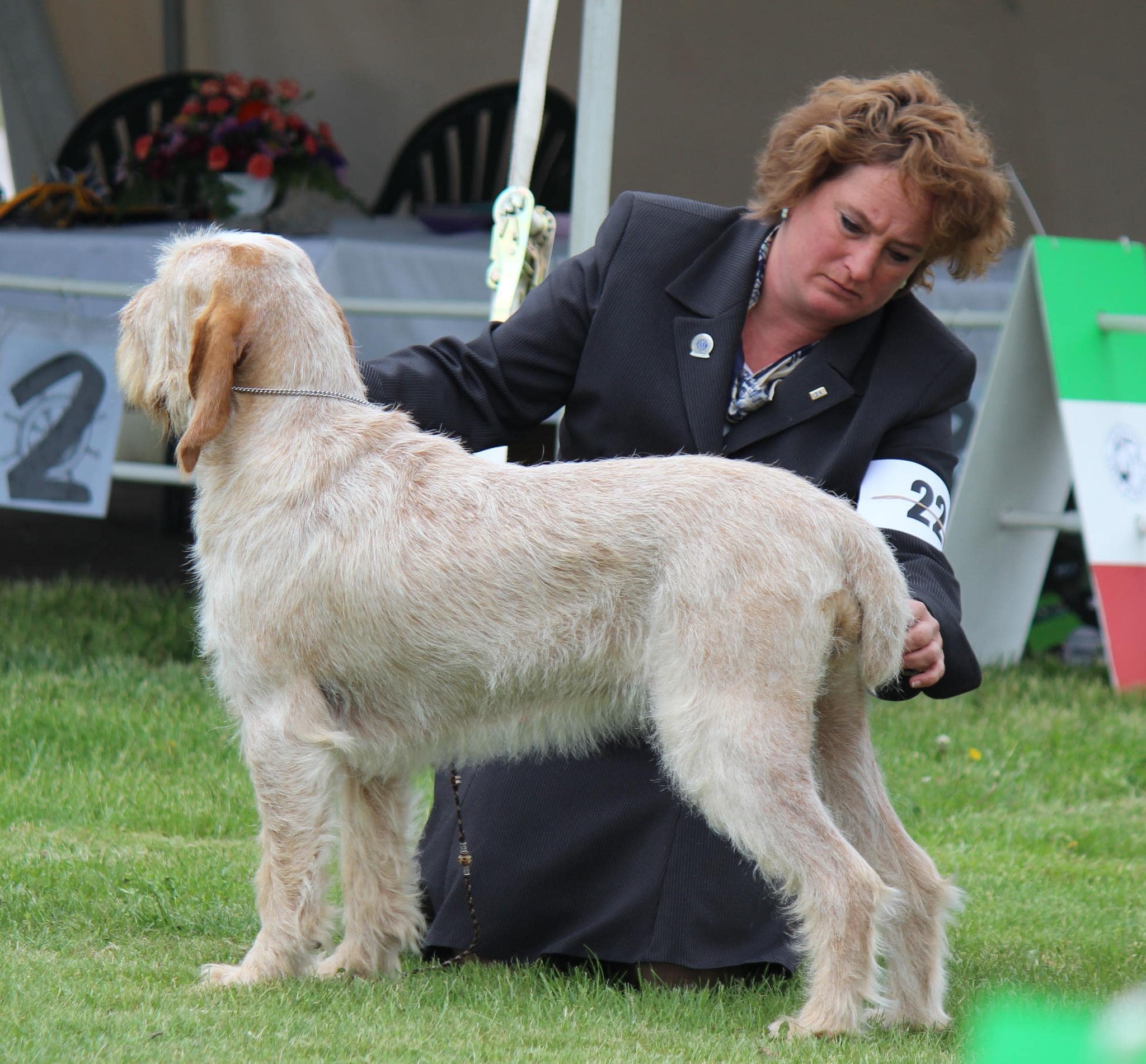
Ch. Elettra del Subasio showing correct coat and skin.
“They developed a really thick skin, which is really, really important to the breed. And the thick skin is as thick as a cow. It’s called the skin of the bull in Italy. And the name Spinoni means thorn. They can go through any kind of cover without even noticing it.
“They have this ability to move quite silently through even the hardest cover, and even though they could break through easily. They just don’t do that. They’re very, I hate to say, careful because that implies slow, but they’re very, very careful about how they move.
“And the other thing they did is that they naturally flush. So, they point and let the human being know where the birds are. Then if the net gets thrown or they throw the net up in the air, Spinoni will then flush the bird into the nets. That’s how they provided food long before there were guns and bows and arrows or anything, actually.
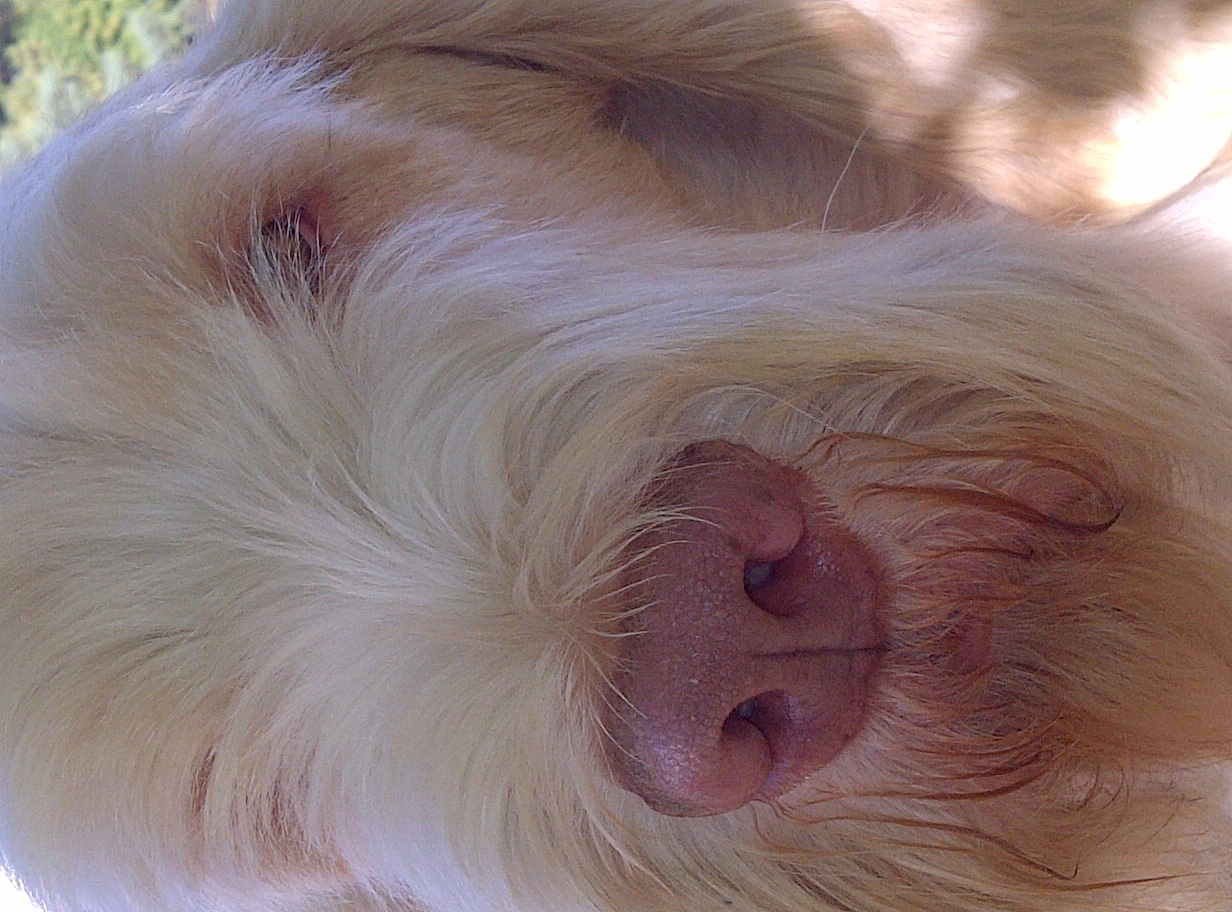
The gentle, empathetic character of the Spinone is paramount.
“The first thing in the original standard, which the Italians still hold today, is they must be of the sweet temperament. So that means in 1,500 years of record keeping there was never a bite in Italy from a Spinone. One of the reasons their temperament must be so sweet is that they have to live with other dogs. Because the Italians usually had Segugios to hunt and take care of the rats and the vineyards and the gardens, and that’s what they depended on for living.
“So, the Spinoni had to be a dog that got along well with other dogs, always. But the first thing in that standard is character. And the most important thing about Spinoni is the character has to be sweet. Dolce, they call it, gentle character. That’s very, very, very important.
“And a little interesting point about World War Two, in the Italian resistance, which one of my mentors was in… They used the Spinoni when they went on things because the Spinoni could tell the difference between Italians coming to meet them and Germans. That was by the diet, we believe, because the Germans ate mostly German food and smelled differently than the Italians did. They could identify the Germans quite readily.
“And remember, the resistance in Italy, after Mussolini fell, were a lot of teenagers 15, 16, 17, 18 year olds, it wasn’t necessarily the old guard. But many of those men were in families that were fifth, six, 7th, 8th generation Spinoni breeders. A lot of the old breeders… would have seven generations of their parents’ records, as Spinoni breeders.”
551 – Sealyham Terriers: Favorites of Royalty and Hollywood
Sealyham Terriers: Favorites of Royalty and Hollywood
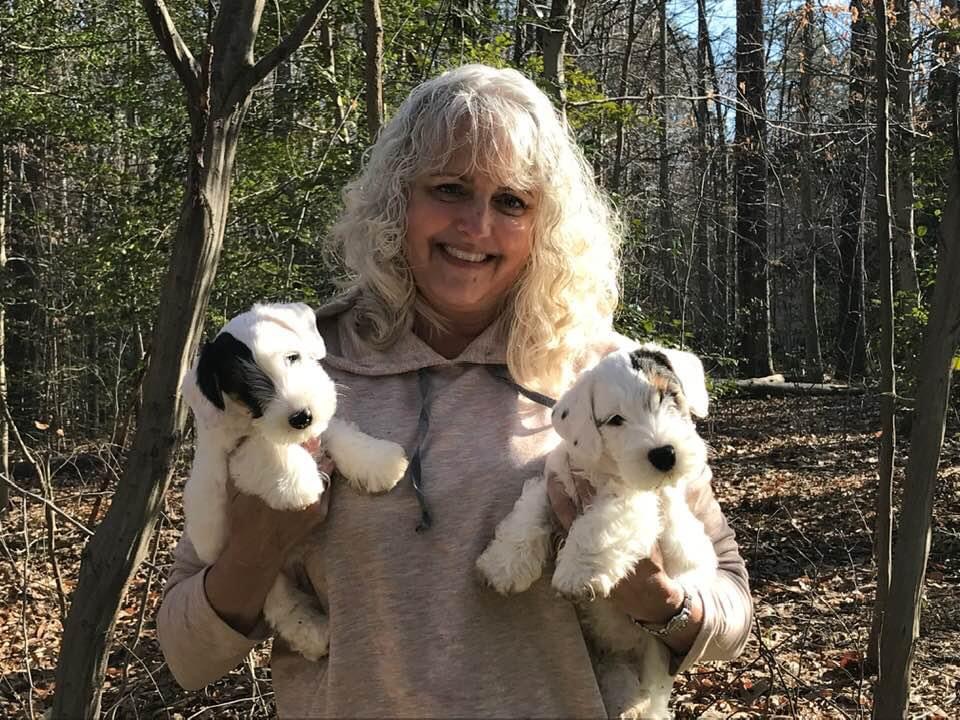
Leslie Jaseph with two of her Seabrook Sealyham Terriers.
Leslie Jaseph joins host Laura Reeves for the next in our Love the Breeds Month, by listener request, Sealyham Terriers.
Sealyham Terriers were once the favored breed of Queen Elizabeth’s sister, Princess Margaret, and Hollywood legends from Alfred Hitchcock to Betty Davis, Rock Hudson and Cary Grant. Today they are ranked 139th out of the 197 AKC breeds by registration numbers.
Developed in Wales and named for the founder’s estate, Sealyhams were used to go to ground after badgers and run with the Otterhounds hunting otters.
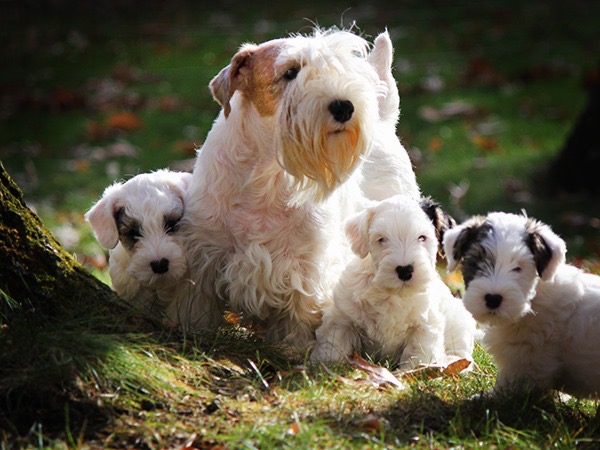 Jaseph, a Sealyham breeder, owner and exhibitor for 50 years, showed her first Sealy in Junior Showmanship.
Jaseph, a Sealyham breeder, owner and exhibitor for 50 years, showed her first Sealy in Junior Showmanship.
“They’re tough in the field,” Jaseph said. “And they’re really engaging. They love to chase and run and track, but they’re not aggressive with other dogs. They are a pack animal, so their pack is their home. Beyond their pack they can be a little more assertive in personality, but within their pack it’s a very distinct order.
“They’re happy to be the boss of the house. If you don’t want to do that, they’ll take over. They’ll be in control. But you might not like how that works. So, you do have to be to stay strong, although you don’t want to be heavy-handed with them at all.
 “They’re very bright, they’re very inquisitive. They have a terrific sense of humor. They do things for effect and watch if you’re paying attention, and then they’ll repeat it. Or maybe sometimes if they see you watching, they’ll just stop and walk away.
“They’re very bright, they’re very inquisitive. They have a terrific sense of humor. They do things for effect and watch if you’re paying attention, and then they’ll repeat it. Or maybe sometimes if they see you watching, they’ll just stop and walk away.
“They were bred to be a dwarf breed, and so they have nice bone. I think our standard mentions strength and power something like 10 times within the opening paragraph and getting into the standard. Good bone, not overdone. Not coarse, still able to be agile.
“I know Sealys that live very, very happily with cats, that’s not a problem. But as far as rodents and other things like that, I think you would need to be very judicious on how you handled that situation. I actually take ours and we’ve done urban rat hunting in Washington DC and so they do have an instinct to do that.
 “So the reason why they’re white is because Captain Edwards wanted them to be able to be spotted when they were out hunting. Now, granted, when you’re in the mud, you’re going to get muddy, but you’re still going to have that white. But a good coated Sealyham really is a dog that the dirt doesn’t cling to them.
“So the reason why they’re white is because Captain Edwards wanted them to be able to be spotted when they were out hunting. Now, granted, when you’re in the mud, you’re going to get muddy, but you’re still going to have that white. But a good coated Sealyham really is a dog that the dirt doesn’t cling to them.
“If they have that harsh, crisp coat, they really don’t stain at all. And they do have a double coat. So you have this 50% harsh coat, 50% undercoat, which was weather resistant and kept them warm and somewhat dry.”
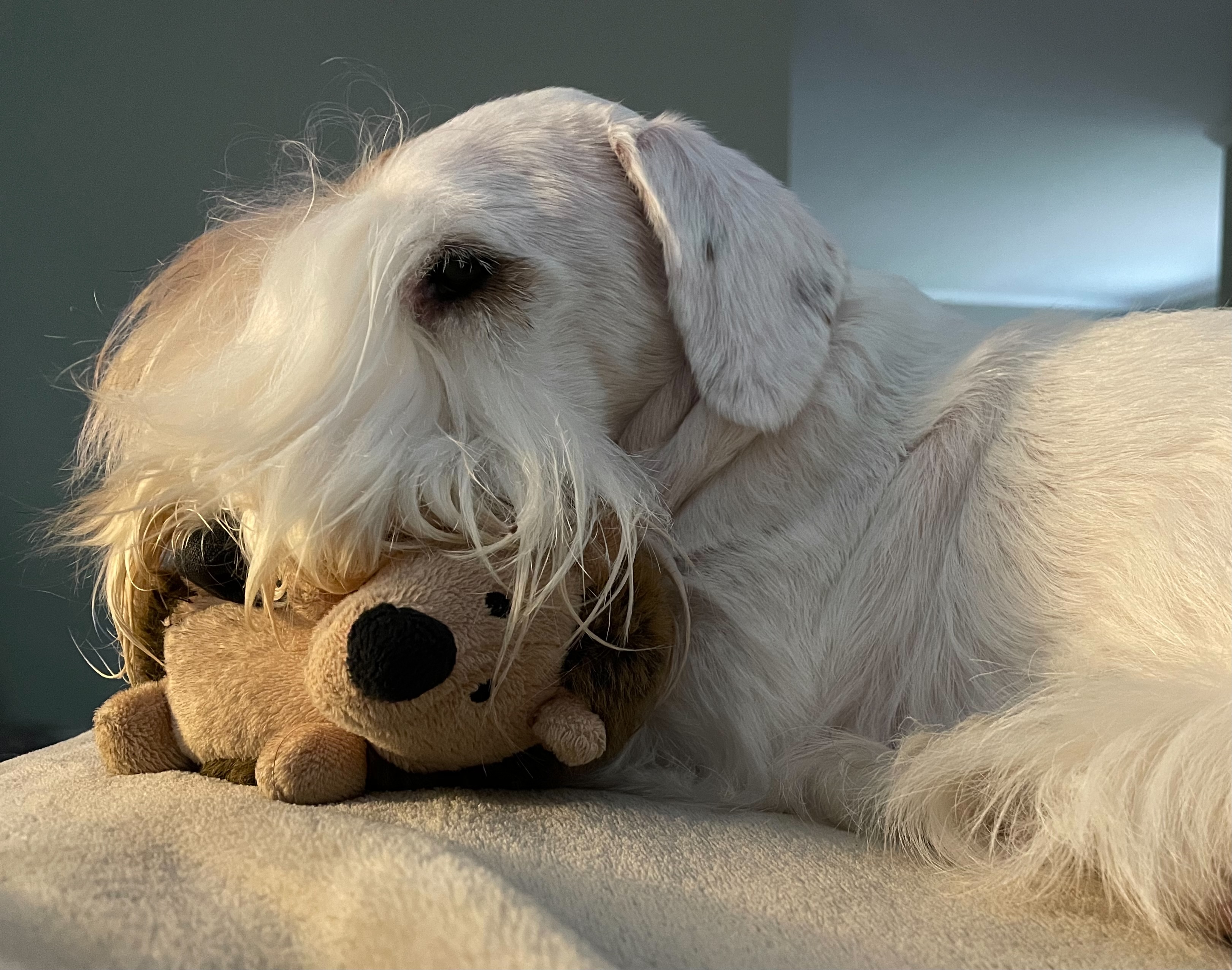 “They do love their people and they want to be with their people. They’re wonderful companions. They love to go for walks. They don’t need to go running, but they do enjoy being with you as companion dogs.”
“They do love their people and they want to be with their people. They’re wonderful companions. They love to go for walks. They don’t need to go running, but they do enjoy being with you as companion dogs.”
549 – Finnish Lapphunds: Trainable, Lovable, Cuddly Dogs of the North
Finnish Lapphunds: Trainable, Lovable, Cuddly Dogs of the North
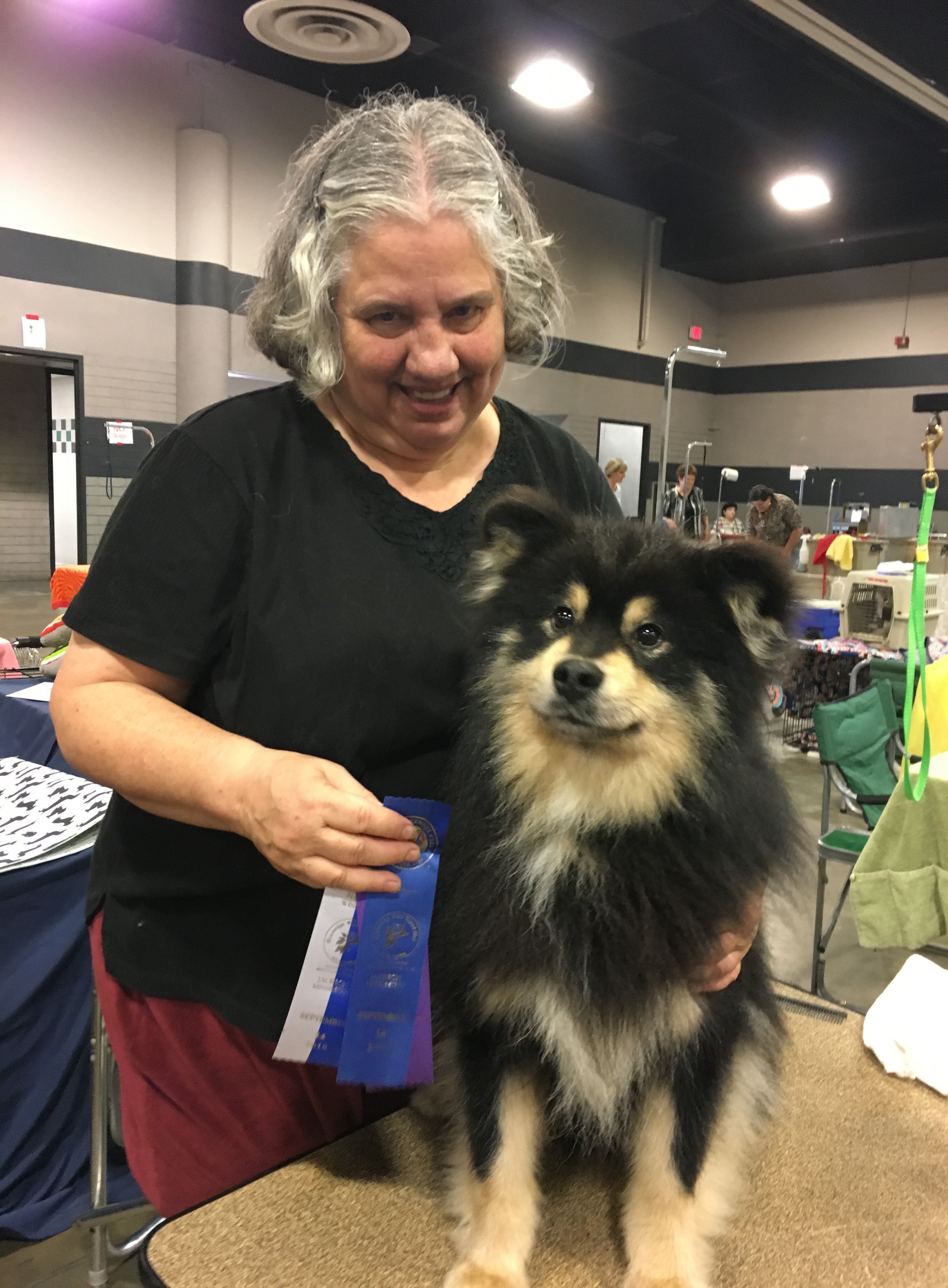
Linda Marden and Tori.
Host Laura Reeves kicks off Love the Breeds month talking with Linda Marden, who imported the first Finnish Lapphunds to the US and worked to have them recognized by the American Kennel Club.
“I very pointedly and purposely set out to import Finnish Lapphunds and get them recognized by AKC,” Marden said. “It took pretty close to 25 years to get it done. I couldn’t find anybody that would export one to the United States. Back then, we didn’t have Internet or anything like that. To them, sending a dog to the United States was basically the same as taking it out and shooting it… it was never going to come back to them. It wouldn’t be part of their gene pool because once they’re gone and registered in the United States … at that point, because we weren’t AKC recognized, we couldn’t send dogs back to them. So that line, as far as they were concerned, was lost. Getting a dog was really difficult.
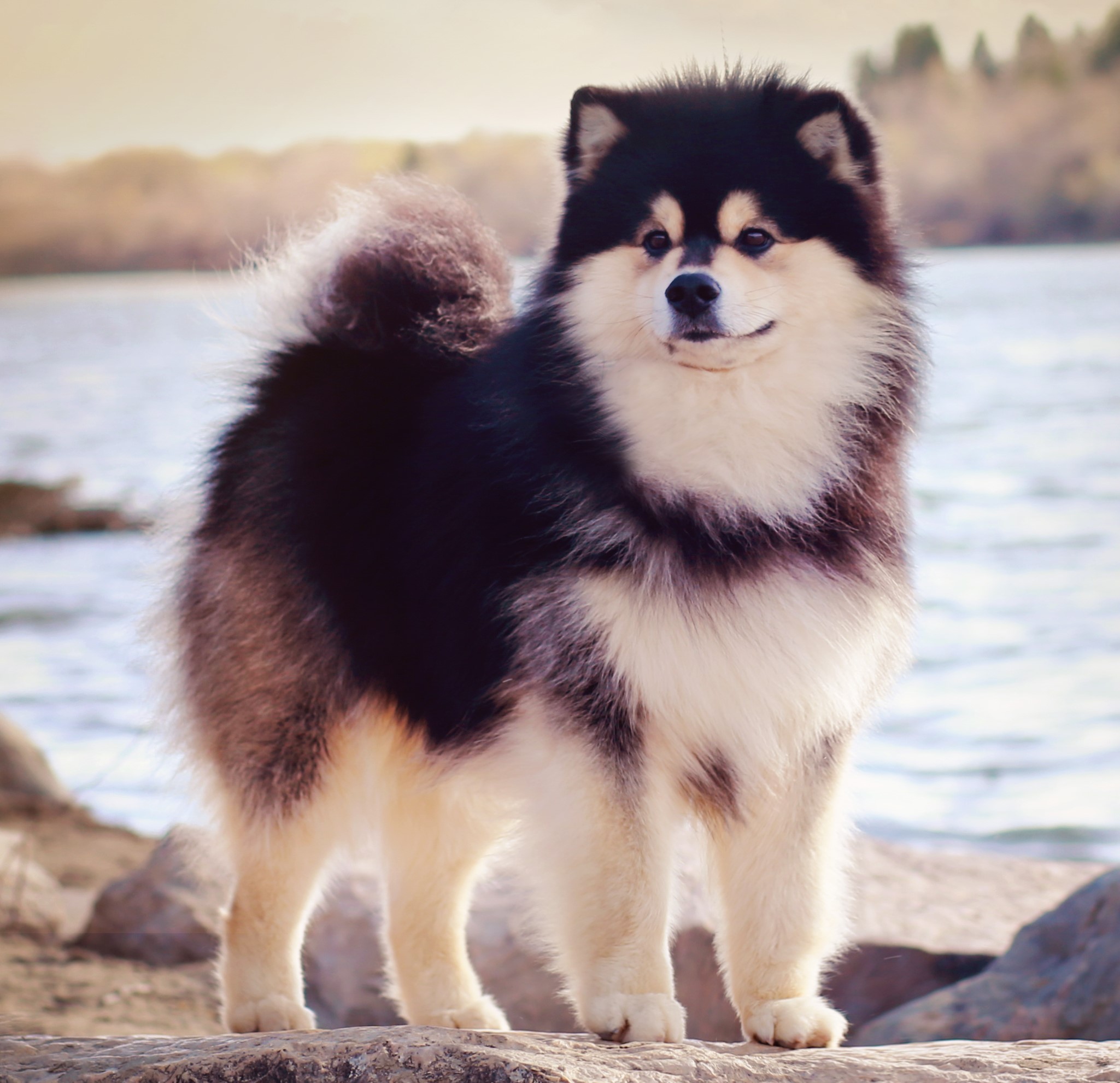
Finnish Lapphunds are a medium-sized double coated Spitz-type breed.
“When I first started, I had a breed which had a very definite well-recorded history and we had multiple generations pedigrees. This was not in any way shape or form a created breed. Every dog I imported had at least a three-generation pedigree, which was an AKC requirement. We never had anything that wasn’t three generations, and they still made us wait until we had 400 dogs in the United States before we could even take another step forward. When I first started working on importing Lappies. It was before AKC had the foundation stock service. So, it instantly became much easier once that got started.
“Finnish Lapphunds obviously are from Finland. That type of breed is all over the northern part of Europe. So, what actual breed you get depends on where in northern Europe you are. So, the “Lapphund” part comes from Lappland, which was an area of Europe that was never a country but “pre-countries” it was recognized area. It covers the northern parts of Norway, Sweden and Finland. And Sammies came from also basically the same area, but it was Russia. So, it’s just the area you were in because these were nomadic people that are relatively isolated. So, the breeds that formed, formed because of the human isolation.

The breed comes in a wide array of colors, love to learn tricks and are very docile with people.
“All of those breeds were kept by the nomadic people and their primary job was to help herd the reindeer. Now, the dogs were multi-purpose. They were not exclusively bred as herding dogs. So, we see differences in their temperaments because of that. They were also used to occasionally pull sleds. They were alarm dogs. They hung out with the people. We all joke that we know exactly what a “three dog night” is. It’s really cold. The dogs lived very closely with their people, and you can see that in their temperaments. All of those breeds actually are exceedingly people oriented because they lived in the tents with the people.”
For more information on the breed: https://www.facebook.com/groups/finnishlappundclubofamerica
548 – Canine Herpes Virus from the Veterinary Perspective
Canine Herpes Virus from the Veterinary Perspective
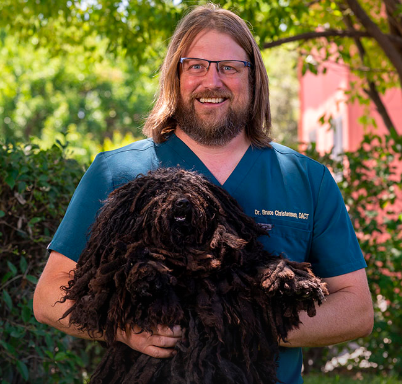
BRUCE W. CHRISTENSEN, DVM, MS, DACT
Dr. Bruce Christensen, DVM from Kokopelli Assisted Reproductive Services, joins host Laura Reeves to talk about treating pregnant dogs and their puppies for Canine Herpes Virus.
Last week we heard from Alaskan Malamute breeder Wendy Korr on her experience with this potentially devastating disease in her litter. Today we are joined by the veterinarian who led the treatment of dam and puppies with a refresher course on CHV.
“Herpes virus is not something that we typically screen for on a routine basis with our breeding bitches,” Christensen said. “It could be argued that maybe we should, but I guess in our conversation today we can probably talk about why that is or isn’t so.
“The bottom line is that it’s a pretty common virus. And so most bitches, and stud dogs, have been exposed to it and have it essentially, although it’s not actively causing disease in most of them. However, the dangerous thing is if a bitch hasn’t been exposed to herpes virus and then she’s initially exposed to it while she’s pregnant, especially in that last half of gestation.
“That would be the most dangerous time because the first time that an animal is exposed to herpes virus, they have the strongest immune response and the least prepared immune response, so the virus has more of a head start. Since the body hasn’t seen it before, there aren’t any lingering antibodies to recognize the virus and mount a quicker subsequent response. So the initial response is a little slower at coming and gives the virus more time to do damage. And that damage during the second-half of pregnancy will involve the fetuses and potentially much more likely infect them.
“If a bitch has been exposed before, then she’ll have antibodies and she’s already got the virus in her, just in the latent state. And if it reproduces or comes back out, her immune system should be adequate enough to protect the puppies that are in utero. So if you find that she’s naive, in other words that she has not been exposed to herpes virus, then you need to be hyper vigilant about keeping her away from other dogs throughout the rest of her pregnancy because you don’t want her to be exposed for the first time during her pregnancy.
“So that dog needs to be on real lockdown and isolation from any outside dogs. If you have dogs in your household that will have contact with her ’cause it just be too difficult to keep them apart, they need to be tested. And if they’re negative, then they could continue to have contact with her and no other dogs. If they’re positive, then you probably wanna temporarily rehome them to keep them away from her during that pregnancy so that they don’t potentially spread it to her while she’s pregnant.
“Most species have their own herpes viruses and they’re not communicable between species. We all know coronavirus jumps between species because of what the world’s gone through in the last couple years, right? Herpes virus doesn’t do that. It pretty much stays true to the species it’s evolved with.
“But once you get a herpes infection, the viruses pretty much behave the same. They go into your cells and they stay in your cells for your lifetime. Now they’re usually quiet and just sit there, not replicating, just quiet inside the cells. Usually, it’s in times of stress that they are triggered. Everybody listening to this podcast is going to be familiar with herpes virus in people, ‘Damn it, I got a cold sore.’ So that’s because the virus. Once you’ve got it, it’s in your body forever and during times of stress it’ll come out and cause those annoying problems. In the dog, it’s the same.
“Once a dog becomes exposed to herpes virus, it’s in the dog for life, but most of the time it’s just quiet inside the cells. During times of stress, it can come back out. And interestingly, in dogs, the clinical signs usually are not necessarily like cold sores, but not too far off. They give blister-like lesions on mucosal surfaces, so it’s similar to a cold sore, but you’ll see these little blisters on their gums or if they’re male dog on their prepuce, if they’re female on their vaginal mucosa, and you’ll see that and that’s it. They don’t cause anything except maybe some minor discomfort. But they are at that point shedding, and they can pass it quite easily from one dog to another.
“The virus is really weak outside the body, so it’s not like it’s gonna live very long in a kennel or in a backyard. Any kind of cleaning product will kill it. Sunlight is gonna kill it. It doesn’t live long like other viruses can in the environment. But passing from dog to dog, you know, they meet each other, they lick each other, they smell each other. They can pass it quite easily that way. And once you’ve got it, you got it.
“One of the major things that keeps herpes virus at bay and just causing these little blister-like lesions and not more is that it doesn’t replicate very well at normal body temperature. So for a dog that’s 99 to 101-ish degrees Fahrenheit and it doesn’t replicate well at that temperature. But if it gets below 97, then now it can replicate pretty fast and furious. In those puppies that are colder than that, if their environment doesn’t keep them warm up in the 99 plus range, then it will do more than blisters. It will attack their kidneys, it will attack their liver, it will attack their lungs. It’ll attack all the major organs of their body and cause very rapid death within a couple days.
“Whether they’re born by C-section or natural, one of the most important things you can do for the puppies is to keep them warm. Remember that their little internal thermostats don’t start fully functioning until they’re somewhere between two and three weeks of age. So up until that point they’re really like little lizards, crawling around and relying on their environment to keep them warm. So, the mother does a good job at that, but she’s not always there so you have to keep the nesting area warm.”
547 – Canine Herpes Virus: Early Detection Saves Puppies
Canine Herpes Virus: Early Detection Saves Puppies
Alaskan Malamute breeder Wendy Corr joins host Laura Reeves to share her story of early detection of Canine Herpes Virus in her pregnant bitch and how she managed the situation to produce healthy puppies. This is the first of a two-part series which also includes an interview with Corr’s lead veterinarian.

November 2021 4-6 Beginner Puppy. Later, breeder, owner, handler Wendy Corr related his story, told here.
Corr said she had never really thought about CHV much, as a long-time breeder, but had recently heard a presentation on the dangers of the disease to pregnant females. On a whim, she asked her veterinarian, Dr. Bruce Christensen, to pull blood a CHV titer test on her confirmed pregnant 3-year-old Malamute.
She was shocked to hear back a couple weeks later that the bitch had titer levels off the charts.
At the direction of Dr. Christensen and his team at Kokopelli Assisted Reproductive Canine Services in Sacramento, CA, Corr started her bitch on a course of acyclovir, a human anti-viral.
Corr, who is a clinical nurse in human medicine, said she was concerned about potential side effects from the drug, which could include cleft palate, but committed to the treatment with that understanding. She also opted for a C-section, rather than a vaginal whelp, in order to limit the puppies’ exposure to the virus in the dam’s body.
Primary among the handling of the four healthy puppies at birth (none with clefts) was incorporating an incubator to keep their body temperature above 99 degrees, the point at which the virus cannot replicate, for the first 2 ½ weeks. Putting the puppies on to nurse every two hours, monitoring temps and keeping mom and puppies content during that time was a daunting challenge, Corr said.
“We had friends who brought us dinner,” Corr said. “We had people who offered to come in and just sit with the dog so I could sleep or take a shower or we could go grocery shopping.”
The entire process took place during the height of COVID lockdowns, enhancing Corr’s challenges.
Stay tuned next week for insight from Dr. Christensen directly on his experience and recommendations on the topic.
546 – Consistency is the Key to Successful Dog Training
Consistency is the Key to Successful Dog Training
Trainer and author Shannon Riley-Coyner joins host Laura Reeves to talk about the key to successful dog training – consistency.
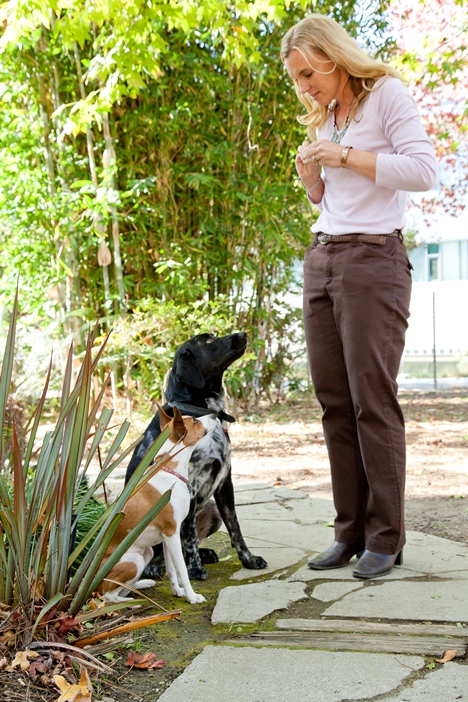 “Really, consistency is something that even as humans, we thrive on,” Riley-Coyner said. “Like if we have a relationship, whether it’s with our children, our spouse, our friends. Inconsistency really creates fear. It creates anxiety. It creates a lack of trust.”
“Really, consistency is something that even as humans, we thrive on,” Riley-Coyner said. “Like if we have a relationship, whether it’s with our children, our spouse, our friends. Inconsistency really creates fear. It creates anxiety. It creates a lack of trust.”
Five Ways to be Consistent
- Be clear about what you are expecting. Does down mean get off or lie down?
- Make a doggy dictionary. What is the word for each behavior?
- Be clear about reinforcement. Clicker? Food? Verbal? Be consistent with the reinforcer!
- Nail your timing. “A punishment that happens 3 seconds after a behavior can be very stressful for a dog. A reinforcement like treat that’s given three seconds after the behavior, it will be confusing. But it won’t be necessarily be stressful.”
- Consistent technique. “Inconsistency is very stressful for a lot of dogs. That’s why it’s so important to have that timing and your techniques be consistent.”
Clarity is kindness
“We need a way of communicating with (our dogs),” Riley-Coyner said. “If I don’t have some consistent words that mean something, we’re going to have a hard time communicating because dogs don’t talk in language like this. They talk with body language and we need to know about these things.”
Consistency for the dogs within the family is critical, Riley-Coyner said. Which is why using consistent words, rules and a similar tone should be part of the family meeting for any new dog.
“Tone will amp up a dog or bring a dog down,” Riley-Coyner said. “It’s a lot of training ourselves.” Consistency from the beginning and building a foundation, she added, enables us as trainers to show our dogs that “clarity is kindness.”



